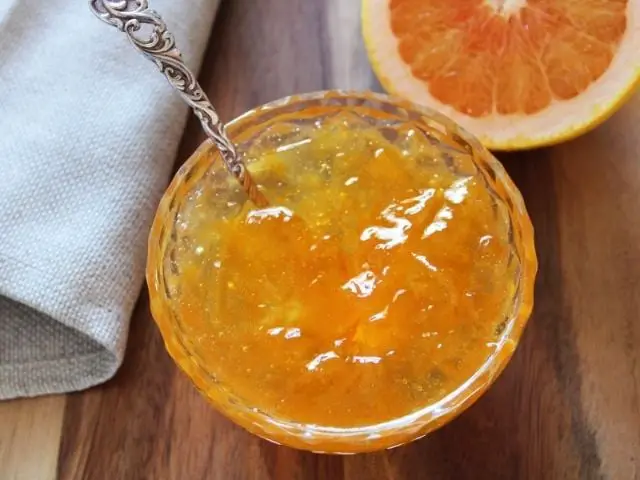
Grapefruit Marmalade
Make your own condiments from seasonal produce and try our Grapefruit Marmalade. This zesty, tangy preserve is a great start to the day.
Prep
: 10
Total
: 25 minutes
Ingredients
For the Marmalade
- 500 g grapefruit - prepared weight
- 1 large lemon
- 1.5 Liter water
- 1.8 kg sugar
Instructions
Please Read First
- Preserve making is quite simple, but we do recommend reading the recipe through first and following these tips: weigh your ingredients for accuracy. do not double the recipe or alter the quantities. yes, it’s a lot of sugar. It’s also a lot of water. When making marmalade, the sugar is not just a sweetener, it also assists with gelling and preservation. When prepared properly, your end result will be the perfect mix of sweet, citrus tang and bitter, as marmalade should be. This is an old-fashioned recipe. Use a very large saucepan as the marmalade needs to rapidly boil and will foam up and you don’t want it to overflow. Ensure the marmalade reaches setting point. Keep in mind the marmalade will be very liquid while hot. Do not over boil as you will risk burning the marmalade. Allow 24-48 hours once jarred for the pectin to activate and the marmalade to set properly. If after this time your marmalade hasn’t set, it likely wasn’t cooked for long enough initially. In this case, add the marmalade back to a clean saucepan with the juice of a fresh lemon. Bring back to the boil and start testing after 5 minutes of rapid boiling.
To Sterilise the Jars
- Sterilise the jars you'll be using to store the marmalade. Choose glass jars with an airtight, metal lid and ensure they have been washed in the dishwasher or by hand in hot soapy water then rinsed well. Check that the metal lids do not have rubber inserts. Preheat the oven to 130 Degrees C (270 F) and place the jars in the oven for 15-20 minutes.
For the Marmalade
- Place 2 saucers or small plates in the freezer, ready to check for the setting point of your marmalade. Thoroughly wash the grapefruit and lemon. Remove each end of the grapefruit to get rid of excess pith. Remove each end of the lemon. Cut the grapefruit and lemon into quarters length ways. Holding two of the quarters together, slice as thinly as possible and remove any seeds.
- Place the citrus slices in a non-reactive bowl. Add the 1.5 Liters of water, cover the bowl and leave the fruit to stand overnight, up to 24 hours. If your bowl is not large enough to accommodate all the water, add what you can and add the remainder the following day. The following day, place the fruit and water into a very large, non-reactive saucepan.
- Over medium-high heat, bring the fruit and water to the boil. Rapidly boil for approximately 15 minutes or until the peel is tender, stirring occasionally with a long-handled wooden spoon.
- Add the 1.8 kg of sugar and stir well to dissolve it. After dissolving the sugar, return the fruit to the boil, stirring occasionally. Continue to stir until the marmalade reaches setting point. When the very aggressive bubbles subside to a slower, gentler boil, that's an indication that your marmalade may have reached setting point. Remove from the heat to conduct the wrinkle test. If not set, continue to boil for another 1 minute and then test again.
- To test for setting point, use the “wrinkle” test. Take one of your saucers from the freezer and pour a small amount of marmalade onto it. Let it cool for a minute then push against the marmalade with the tip of your finger. If the surface wrinkles slightly, it means setting point has been reached. Alternatively, if you are not confident checking this way, use a jam/candy thermometer which you clip to the side of your saucepan. Your marmalade has reached setting point when the temperature reaches 104.5 degree C or 220 degrees F. At this time, your marmalade will look very liquidy - it can take 24-48 hours to completely cool and set. Please note, this recipe will produce marmalade which has a soft set; it will not be as firm as many commercial varieties which often contain additives.
- Take the mixture off the heat. If there is any scum on the marmalade, add a teaspoon of butter and stir; that should settle the scum.
- Let the marmalade stand for about 10 minutes to allow the fruit to settle. If you bottle it immediately, the fruit will not be evenly distributed but will settle at the top of the jar.
- Remove your jars from the oven and carefully ladle the marmalade into the heated, sterilised jars. The jars should be filled as full as possible to minimise the amount of air between the marmalade and the lid. The marmalade should not touch the lid. Seal tight once filled with marmalade. Be very careful. Splashing yourself with hot marmalade will result in a very serious burn.
Notes
When making marmalade, the sugar is not just a sweetener, it also assists with gelling and preservation. Store in a cool, dark place. Refrigerate after opening.